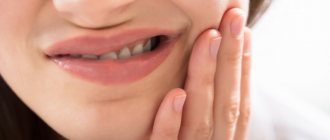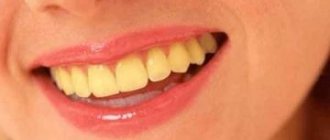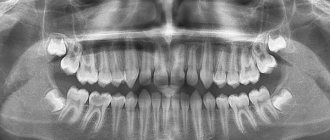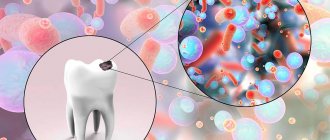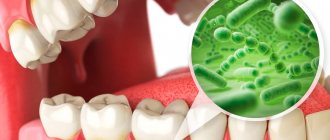It's no secret that smoking causes irreparable harm not only to the lungs, but also to other organs and systems of the body, and is the cause of the development of many pathological processes. The bad habit of “blowing smoke” very often becomes the cause of serious diseases of the oral cavity, namely stomatitis, also called smoker’s leukoplakia.
Stomatitis is an inflammation of the oral mucosa, therefore, in addition to smoking, other factors also play an important role: dietary habits (love of spicy, sour, hot foods), consumption of strong alcoholic beverages, taking certain medications, vitamin deficiencies, some allergic reactions, etc. Tobacco smoke destroys beneficial bacteria from the surface of the mucous membrane, the microflora is disrupted and stomatitis forms. Despite the fact that stomatitis is a disease that occurs in every second baby (of course, for other reasons), heavy smokers should not let the situation take its course, as this can be extremely dangerous. Therefore, treatment must be carried out in a timely manner.
Dentists at the Dudko and Sons clinic recommend taking the symptoms of stomatitis in adults seriously. Because if the irritating factor is not eliminated for a long time and proper treatment is not followed, the disease can transform into a malignant form. Tobacco smoke contains a large number of harmful substances: nicotine, tar oils, hydrocyanic acid, hydrogen sulfide, ammonium, carbon monoxide, phenols. Nicotine itself, when smoked, does not have a significant effect on the mucous membranes of the oral cavity and respiratory tract, but purine, which is formed during its destruction, is a very dangerous substance that has a high carcinogenic effect. Nicotine stomatitis occurs in 13% of patients with various dental diseases. Their refusal of treatment or failure to properly follow the doctor’s recommendations can lead to serious complications and even oral cancer.
The mechanism of the effect of cigarettes on teeth
Carcinogens and tarry substances released by tobacco during its smoldering settle on the surface of the tongue, gums, and oral mucosa. With each new cigarette, the layer of these substances thickens. Bacterial microflora quickly multiplies underneath it, leading to an inflammatory process.
Important: The number of cigarettes smoked is directly proportional to the risk of developing periodontal disease. According to medical statistics, about 95% of smokers aged 35-45 years experience periodontitis. However, in 90% of them treatment is ineffective. This threatens complete loss of teeth by the age of 70-75.
Cigarette smoke can cause enamel cracking. The healthy microflora of the mouth is disrupted. The oral cavity is affected by toxins released during the combustion of tobacco. Among them:
- Resins.
- Hydrocyanic acid.
- Methane.
- Nicotine.
- Tar.
- Ammonia derivatives.
The raid seems safe only at first glance. In fact, it settles in the deep layers of enamel, in every microcrack, and can even affect the top layer of dentin (the base of the tooth). Bacteria, food, and tar released by tobacco penetrate into small cracks. This is why teeth lose their natural, white tint and it becomes impossible to remove plaque with a toothbrush. The shade of the enamel becomes brown, gray or yellow. Over time, hard-to-remove black deposits form on the dental tissues at the roots of the teeth.
Why is tobacco considered harmful to the oral cavity?
For a long time, smoking was considered completely natural and safe, in fact, some experts even recommended tobacco to (supposedly) improve blood circulation and lung function. Everyone smoked: from ordinary peasants and workers to prominent politicians and movie stars of the first magnitude. The aestheticization of smoking was largely due to high-profile advertising campaigns and the activity of large corporations that could afford to spend millions to promote their products.
Experts spoke about the dangers of smoking in the 19th and early 20th centuries, but few listened to them. It was only in the second half of the twentieth century that the rise of diseases associated with excessive tobacco use and published research helped put the situation into perspective. Dentists were among those who drew attention to the dangers of smoking. Many studies have been conducted that have proven that smoking is one of the factors that provoke caries, periodontal inflammation and a number of other dental diseases.
Cigarettes contain hundreds of substances and components harmful to the oral cavity: nicotine, carcinogens, acetone, hydrocyanic acid, etc. “Smoker's teeth” have become one of the most common informal diagnoses in dentistry. This was also due to the fact that regular tobacco consumption was complemented by poor hygiene, poor diet and neglect of dental treatment. Someone will object and say that many smokers have completely healthy teeth and sometimes even a snow-white smile. This only means that a person makes great efforts to maintain dental health and has good genes, but in general this bad habit negatively affects the condition of the oral cavity and can still lead to problems and complications later.
Consequences of smoking
From the first months of smoking, tobacco gradually changes the composition of saliva, dulls the functioning of receptors, and also:
- May cause chronic gum inflammation and soreness.
- Promotes bleeding of oral tissues.
- Gradually destroys the integrity of tooth enamel.
- Can lead to stomatitis, the appearance of ulcers on the cheeks, gums, and tongue.
- Causes an unpleasant odor in the human mouth.
Tobacco smoke also negatively affects the healing process of oral tissues. In this regard, people who smoke have a harder time with dental procedures: fillings fall out more often, and after tooth extraction, the hole will take longer to heal.
How does tobacco affect the oral mucosa?
The teeth of a healthy person and a smoker also differ in that the latter are much more likely to have problems with the oral mucosa. The mildest of these are dry mouth (xerostomia) and an unpleasant odor, which increases due to the breakdown of components of tobacco products. Due to inhalation of hot smoke, tobacco stomatitis and leukoplakia often occur - compacted spots on the mucous membrane, framed by a white coating. In heavy smokers, doctors often diagnose leukokeratosis, which manifests itself in the form of seals (usually on the lower lip). This disease may well be a precursor to cancer, since the tumor often becomes malignant over time. Smoking often becomes one of the causes of gingivitis and periodontitis, and also significantly complicates the treatment of any inflammatory processes in the periodontium.
Do-it-yourself whitening
Since it is necessary to constantly visit the dentist to remove plaque, smokers are trying to find ways to whiten their teeth on their own. Methods that can be found on the Internet can be dangerous, but more often they are simply useless:
- Whitening on your own will not remove plaque between your teeth.
- It is impossible to clean the fissures and grooves in the chewing teeth with a toothbrush and improvised means.
- The gingival area of the tooth also cannot be cleaned without dental instruments.
None of the self-whitening methods will remove plaque trapped in microcracks in the enamel.
Professional dental hygiene can help a smoker. The procedure does not whiten the enamel to ideal levels, but it does remove surface pigments. Hygiene is mandatory before the whitening procedure.
Preventing smoker's plaque
In order to reduce the likelihood of smoker plaque forming on your teeth in the future, it is worth systematically reducing the number of cigarettes you smoke per day.
For constant oral hygiene, it is recommended to use special products created specifically for those who smoke. Preventive toothpastes, gels and rinses help remove bacteria and additionally have a deodorizing effect.
If a person continues to abuse tobacco, brushes his teeth irregularly or incorrectly, or does not go to a hygienist for preventive maintenance, smoker’s plaque on his teeth will reappear. Therefore, if you cannot give up cigarettes, take care of high quality hygiene.
You can remove smoker's plaque at the Doka-Dent clinic in Moscow. To do this, sign up for the procedure on the website or by phone.
Methods of teeth whitening in dentistry
There are several types of professional dental teeth whitening. Your doctor can advise you on the most effective method.
Mechanical bleaching
This method is the most accessible and simple. To clean the enamel, dental attachments are used, with the help of which plaque and stones are effectively removed. After the procedure, the doctor applies a gel to the teeth that protects the enamel.
Chemical procedure
The method is gentle. After it, the teeth become lighter by just a few shades. The gums are covered with a latex protective sheet, after which a concentrated whitening solution is applied to the teeth. The procedure will not apply if the patient has veneers, crowns or fillings.
Photobleaching
The procedure allows you to whiten your teeth by 7-8 tones. The doctor applies the whitening gel and shines a lamp on it. The procedure lasts from 15 to 45 minutes. After the procedure, the doctor applies a product with a high fluoride content to reduce tooth sensitivity.
How can we help you?
The Alfa-Dent dental clinic offers a wide range of procedures aimed at treating and preventing diseases of the dentofacial apparatus.
We offer you the following procedures:
- Veneering and lumineering;
- Comprehensive cleaning (ultrasonic removal of tartar, teeth polishing);
- Whitening (“Opalescence Xtra Boost”, “Air Flow”);
- Selection of aligners and preparations for home whitening;
- Treatment of periodontitis (depending on severity and stage);
- Treatment of caries.
If you smoke and are worried about possible dental problems, now is the time to prevent them. The specialists of the Alfa-Dent clinic will be happy to help you in the treatment and prevention of dental diseases.
Professional teeth cleaning from plaque
At the Dental Center on Shabolovka, professional teeth cleaning is carried out to effectively remove smoker’s plaque. To do this, one of the modern methods of teeth cleaning can be used.
- Mechanical cleaning
- the procedure is carried out manually, using ultrasound or Air-Flow and is reduced to the mechanical destruction of plaque and stone. - Chemical cleaning
is a procedure that involves the application of special dental solutions that soften and break down plaque and tartar, allowing them to be removed from the surface of the teeth. - A combined method
is a procedure that includes chemical and mechanical cleaning of teeth, thanks to which you can achieve the best visible result.
Once the smoker's plaque has been removed, the dentist will grind and polish the surface of the teeth, which will significantly reduce the rate at which the problem reappears.
Important to remember!
The popular teeth whitening procedure is carried out only after professional cleaning.
Why do smokers get toothache?
The destructive effect on tooth enamel leads to toothache from smoking . The mechanism of pain is associated with several factors:
- increased overall sensitivity due to thinning of the enamel;
- inflammation of the gums due to the penetration of bacteria;
- development of pulpitis (inflammation affecting the root).
Increased sensitivity leads to the fact that a person feels pain when eating foods that are too cold or hot, sweet, sour, or overly spicy foods. Gradually, the situation worsens, then any impact on the damaged enamel begins to cause pain.
Smoking after tooth extraction
Modern dentistry offers effective and painless methods of tooth extraction. Patients do not experience any discomfort during the procedure, but they are still worried and cannot resist smoking a cigarette after the treatment is completed.
However, dentists believe that smoking and dental health are incompatible things.
Cigarettes after removing affected teeth, especially if we are talking about wisdom teeth, can cause complications. In addition, tobacco smoke has an irritating effect on the wound surface, causing pain and aggravating inflammation. Smokers are advised to abstain from the habit at least in the first day after removal, and better yet, until complete healing.
Smoking after dental implantation
Dental implantation is one of the most common prosthetic methods, which allows you to achieve an ideal aesthetic and functional result. There are many reasons why you should give up a bad habit during the procedure and recovery:
- slowing down the rate of healing of wound surfaces after implant installation;
- slower engraftment of the implant in the bone tissue, as well as an increased risk of rejection;
- increased risk of infection and development of pain syndrome;
- negative impact on the appearance and functional properties of the crown after installation.
Smoking harms not only natural teeth, but also artificial crowns, gradually affecting their color. A bad habit causes the structure to serve less than it should. You have to change crowns more often, which are not cheap.
Removing plaque using folk remedies
Traditional medicine does not stand aside from dental problems. And to eliminate smoker’s plaque, she suggests using the well-known baking soda. To do this, you need to mix it with tooth powder or toothpaste and clean your teeth very thoroughly with this mixture. But it must be taken into account that this mixture can be used no more than 2 times a week, which is clearly not enough to remove cigarette stains. Otherwise, baking soda will gradually soften tooth enamel and negatively affect the condition of your gums. Often after such an “execution” there appears profuse bleeding of the gums and increased sensitivity of the enamel, which begins to react painfully to “cold” and “hot”.
There is also a safer method of traditional medicine that allows you to remove smoker’s plaque. To do this, immediately after smoking a cigarette, you need to chew a slice of lemon, green apple or strawberry for a long time. The fruit acids contained in these products will prevent plaque formation. But at the same time, they have a destructive effect on tooth enamel and cause its gradual thinning. And it is unlikely that any smoker will decide to undertake such a complex “ritual” after each cigarette smoked.
Condition of teeth in a smoker
The dentition of a smoker has characteristic changes that occur with prolonged use of cigarettes in large quantities:
- Formation of tartar containing tobacco combustion products in large quantities.
- The gums become looser, which leads to the gradual progressive formation of periodontal pockets. Food debris accumulates in these cavities, increasing the risk of developing an infectious process.
- The effect of smoking on teeth is the severe destruction of enamel, which begins with microscopic damage and ends with deep cracks.
- Gradual destruction of the tooth from the inside. In advanced cases, pieces may break off when chewing solid food.
- Reducing the size of crowns and expanding the distances between them due to sedimentation of the mucous membrane. Gradual loosening of teeth followed by their loss.
Gradual damage to the dentofacial apparatus progresses and spreads beyond the oral cavity, affecting the larynx.
The danger of untimely treatment and plaque removal
The appearance of cigarette residue cannot be ignored! Especially if it is accompanied by gingivitis, bad breath and bleeding gums. Failure to promptly seek help and remove plaque will lead to the progression of gingivitis, which will cause periodontal disease - periodontitis. In turn, periodontitis is accompanied by mobility of the dentition, which can ultimately result in tooth loss.
We should not forget about such a dental problem as caries, the main reason for the development of which is dental plaque. The pathogenic microorganisms that “live” in it, day after day, destroy not only the enamel, but also the hard tissues of the tooth, which will ultimately lead to its loss.
